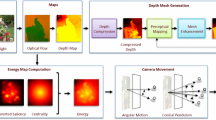
Overview
- Book on important application areas of 3-D cinematography, covering recent developments in computer vision and computer graphics
- The book focuses on techniques specifically dedicated to dynamic scenes, including moving cameras and lights, and highly dynamic live-action scenes
- The authors take a look into real-life applications, and survey leading-edge research perspectives that can lead to such applications as 3-D recording of sports in stadiums or live performances in theater stages
- Includes supplementary material: sn.pub/extras
Part of the book series: Geometry and Computing (GC, volume 5)
Access this book
Tax calculation will be finalised at checkout
Other ways to access
About this book
Similar content being viewed by others
Keywords
Table of contents (13 chapters)
-
Front Matter
-
3-D Cinematography and Applications
-
Front Matter
-
-
3-D CINEMATOGRAPHY AND APPLICATIONS
-
Recent Developments in Geometry
-
Front Matter
-
-
Recent Developments in Image Processing
-
Front Matter
-
Editors and Affiliations
Bibliographic Information
Book Title: Image and Geometry Processing for 3-D Cinematography
Editors: Rémi Ronfard, Gabriel Taubin
Series Title: Geometry and Computing
DOI: https://doi.org/10.1007/978-3-642-12392-4
Publisher: Springer Berlin, Heidelberg
eBook Packages: Mathematics and Statistics, Mathematics and Statistics (R0)
Copyright Information: Springer-Verlag Berlin Heidelberg 2010
Hardcover ISBN: 978-3-642-12391-7Published: 21 July 2010
Softcover ISBN: 978-3-662-50586-1Published: 23 August 2016
eBook ISBN: 978-3-642-12392-4Published: 29 June 2010
Series ISSN: 1866-6795
Series E-ISSN: 1866-6809
Edition Number: 1
Number of Pages: X, 305
Topics: Mathematics, general, Artificial Intelligence, Classical Electrodynamics



